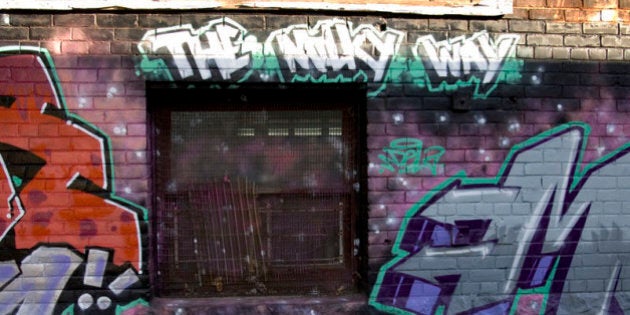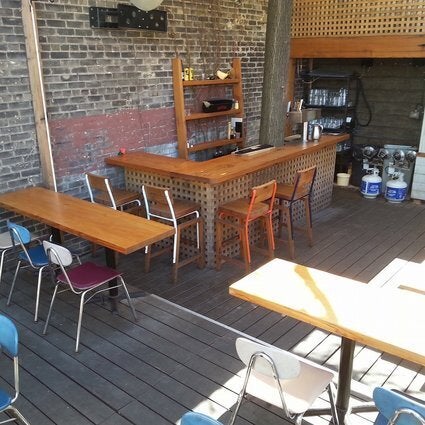
Queen Street West has always been the part of Toronto that I love the most.
From the artists drawing on the sidewalk with pastels, to the street performers, psychics, jazz bands standing on the corner playing for tuition, punks, skaters, and the truly fashionable, Queen Street West explodes with individuals, artists, writers, musicians and creative freedom. From the vibrant murals of graffiti alley to the live music clubs, the vegetarian and Roti restaurants, the bookstores, galleries and Grange and Trinity Bellwoods parks, it has always been the place where I feel most at home.
My first novel, Too Much on the Inside, which was published in June by Quattro Books, is set entirely on Queen Street. Like my characters, I instantly fell in love the first time I visited it, as a teenager.
It was my mother who brought me, after I repeatedly expressed claustrophobia and frustration at their choice of Toronto neighbourhoods after we moved here from South Africa. We lived at Bathurst and Glencairn, which was pretty and suburban and boring.
My mom and I loved Queen Street for entirely different reasons: she for the amazing boutiques, local designers and the upscale art galleries, me for the juxtaposition of glitter and grime that made the area so incredibly compelling.
It was like hearing Sonic Youth or Black Flag as they walked through their neighbourhoods, or seeing a Bukowski, Jim Carroll or Heather O'Neill poem in real life: halfway houses next door to photography studios, vintage clothing stores and art galleries overlooking CAMH, methadone clinics opening out onto stores that sold cotton t shirts for two hundred dollars.
Nothing expresses this better than the time I tried to get my mother to go into Black Market clothing with me:
My mom, suspiciously: "Is this a second hand clothing store?"
Me, all eager: "Yeah!"
My mom: "Wait, you want to try on, and maybe buy other people's clothes?"
Me: "Well, if they fit me, I mean."
My mom: "What if a prostitute owned those clothes?"
Me, trying not to laugh: "Then she had excellent taste."
Pausing to let it sink in. "I hope all the clothes have great history. I wonder if the owners know."
Like the characters in my novel, I have lived all along Queen Street West, from John to Parkdale. I have found a genuine sense of loyalty and artist community unlike any I could ever have imagined. (Last year's I heart Parkdale campaign, where the community listed their reasons for deeply loving the neighbourhood after Councillor Giorgio Mammoliti made some ridiculous statements about it, is a great example.)
Like anything people identify strongly with, there is a real expectation of consistency.
People are always accusing Toronto's most punk rock neighbourhood of selling out.
People have complained about the rise of condos and townhouses from Carr Street to the Chocolate Lofts for years. People have complained about chain stores and our beloved street turning into an outdoor mall for years. (I remember musician friends raging about Bluenotes carrying Nirvana and Ramones t-shirts) I remember when Lululemon, then Urban Outfitters and H&M and now recently, Anthropologie moved in. When a Starbucks went up, first on Dovercourt and then on Bathurst, people were furious. The area is going to lose its character, people feared.
The artists are being pushed further and further south and west, they said, until eventually we are all either residents of Rob Ford's Etobicoke or living on house boats in the lake near Sunnyside beach.
I've always found all of this silly and beside the point- it's the marriage of art and commerce, of multiculturalism and local culture, and the socio-economic mix that makes the area so unique.
The biggest problem with gentrification- that it drives the rent and studio and store leases up -- has also caused expansion into some of the coolest neighbourhoods just off Queen, from Ossington, to Bellwoods, to Beaconsfield and Dufferin. It has also brought a bigger mix of people to the area, and broadened the audience for local art and music and writing. Since the area was declared a heritage zone as of 2007, preservation seems to be everyone's collective goal. Gentrification also makes the neighbourhood safer for women to walk in at night.
I'm not saying commercialization doesn't annoy me too (I mean, who really needs another Hero Burger, or a Yogurty's? ) I prefer the small town friendly feeling of having coffee at the Mascot or Le Gourmand, eating tsel momo at Tibet Kitchen or green tea kit kats at Sanko. I prefer the quirks of the food co-op or the farmer's markets to the Loblaws, and the magic of locally designed clothes.
When I find myself getting down about these things, I remind myself that the fabric and button stores at Spadina, the High Fidelity clerks at Queen Video and Rotate This, the amazing indie bands at the Horseshoe, the Gladstone and the fresh smell of urine as I stare at beautiful, vibrant art in Graffiti Alley or the Milky Way still remain comfortingly the same.
ALSO ON HUFFPOST:
